
USS Underhill (DE-682) was a Buckley-class destroyer escort of the United States Navy during World War II. Built in 1943, she served in the Atlantic, the Mediterranean, and the Pacific until her sinking in a suicide attack by a Japanese Kaiten manned torpedo on 24 July 1945.
BAP Pacocha (SS-48) was a submarine of the Marina de Guerra del Perú named for the 1877 Battle of Pacocha, in which the Peruvian ironclad Huascar clashed with the Royal Navy. Formerly USS Atule (SS-403), a Balao-class submarine with a GUPPY IA upgrade, she had been sold to Peru and commissioned on 28 May 1974. She was rammed and sunk by a fishing trawler on 26 August 1988.
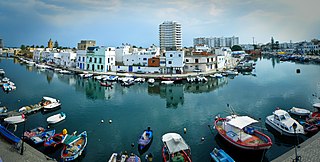
Bizerte or Bizerta the classical Hippo, is a city of Bizerte Governorate in Tunisia. It is the northernmost city in Africa, located 65 km (40mil) north of the capital Tunis. It is one of the oldest known settlements in Tunisia, having been founded by settlers from the Phoenician port of Sidon around 1100 BC. Although archaeologists have established that no Phoenician settlements in the West Mediterranean date to before the 9th century bc. It is also known as the last town to remain under French control after the rest of the country won its independence from France. The city had 142,966 inhabitants in 2014.

German submarine U-534 is a Type IXC/40 U-boat of Nazi Germany's Kriegsmarine built for service during World War II. She was built in 1942 in Hamburg-Finkenwerder by Deutsche Werft AG as yard number 352. She was launched on 23 September 1942 and commissioned on 23 December with Oberleutnant zur See Herbert Nollau in command.

Suffren was a predreadnought battleship built for the Marine Nationale in the first decade of the twentieth century. Completed in 1902, the ship was assigned to the Escadre de la Méditerranée for most of her career and often served as a flagship. She had an eventful career as she twice collided with French ships and twice had propeller shafts break before the start of World War I in 1914. Suffren was assigned to join the naval operations off the Dardanelles, where she participated in a series of attacks on the Ottoman fortifications guarding the straits.

I-401 was an Imperial Japanese Navy Sentoku-type submarine commissioned in 1945 for service in World War II. Capable of carrying three two-seat Aichi M6A1 "Seiran" float-equipped torpedo bombers, the Sentoku-class submarines were built to launch a surprise air strike against the Panama Canal. Until 1965, the Sentaku-type submarines — I-401 and her sister ships I-400 and I-402 — were the largest submarines ever commissioned.

The Charlemagne class consisted of three pre-dreadnought battleships built for the French Navy in the 1890s. The ships spent most of their careers assigned to the Mediterranean Squadron. They had oddly eventful peacetime careers as they were involved in four accidental collisions between them, one of which sank a French submarine with all hands. Saint Louis was usually a fleet flagship during her career and Charlemagne twice participated in the occupation of the port of Mytilene on the island of Lesbos—then owned by the Ottoman Empire—once as part of a French expedition and another as part of an international squadron.

Charlemagne was a pre-dreadnought battleship built for the French Navy in the mid-1890s, name ship of her class. She spent most of her career assigned to the Mediterranean Squadron. Twice she participated in the occupation of the port of Mytilene on the island of Lesbos, then owned by the Ottoman Empire, once as part of a French expedition and another as part of an international squadron.

Saint Louis was the last of the three Charlemagne-class pre-dreadnought battleships built for the French Navy in the mid-1890s. She spent most of her career assigned to the Mediterranean Squadron and usually was chosen to serve as a flagship. The ship was involved in two accidental ramming incidents with two other French warships in her career, one of which sank a submarine.

USS Lydonia (SP-700) was United States Navy patrol vessel in commission from 1917 to 1919 that saw service during World War I. Prior to her U.S. Navy service, she had been William A. Lydon's private yacht, Lydonia II, from 1912 to 1917. She spent most of the war based at Gibraltar, escorting and protecting Allied ships in the Mediterranean and along the Atlantic Ocean coast of Europe. After her U.S. Navy service ended, she served from 1919 to 1947 in the United States Coast and Geodetic Survey as the coastal survey ship USCGS Lydonia (CS-302).
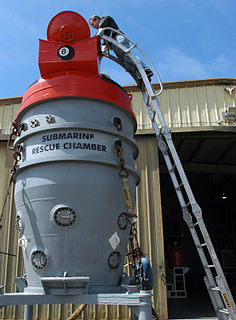
The McCann Submarine Rescue Chamber is a device for rescuing submariners from a submarine that is unable to surface.

The Bizerte crisis occurred in July 1961 when Tunisia imposed a blockade on the French naval base at Bizerte, Tunisia, hoping to force its evacuation. The crisis culminated in a three-day battle between French and Tunisian forces that left some 630 Tunisians and 24 French dead and eventually led to France ceding the city and naval base to Tunisia in 1963.
The Hrabri class consisted of two submarines built for the Kingdom of Serbs, Croats and Slovenes by the Vickers-Armstrong Naval Yard, on the River Tyne, in the United Kingdom. Launched in 1927, the vessels were named Hrabri (Brave) and Nebojša (Fearless). Their design was based on that of the British L-class submarine of World War I, and they were built using parts originally assembled for L-class submarines that were never completed. The Hrabri-class were the first submarines to serve in the Royal Yugoslav Navy, and the class was joined by the two smaller French-made Osvetnik-class submarines to make up the pre-war Yugoslav submarine force. They were armed with six bow-mounted 533 mm (21 in) torpedo tubes, two 102 mm (4 in) deck guns and one machine gun, and could dive to 60 metres (200 ft).

The Shinkai (しんかい) is a manned research submersible that can dive up to a depth of 600 m. It was completed in 1970, and until 1981 it had the greatest depth range of any manned research vehicle in Japan. The Shinkai is owned and run by the Japan Coast Guard and it is launched from the support vessel Otomemaru (乙女丸).
French submarine Fresnel (Q65) one of 18 Pluviôse-class submarines built for the French Navy in the first decade of the 20th century.
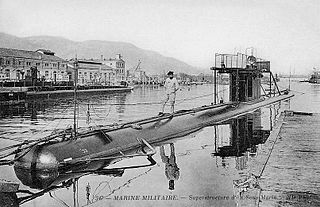
Saphir was one of six Émeraude-class submarines built for the French Navy in the first decade of the 20th century.

The Farfadet-class submarines were a group of submarines built for the French Navy at the beginning of the 20th century. There were four vessels in this class, of the Maugas type. They had little success in service and were converted to other use after the loss of two vessels in diving accidents. All were disposed of prior to the outbreak of the First World War.
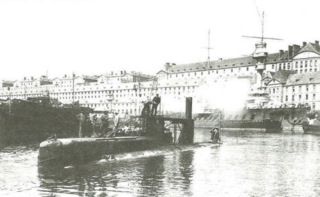
The French submarine Z was an experimental submarine built for the French Navy between 1902 and 1905. It was laid down in April 1902, launched in March 1904 and completed in 1905. Designed by Gabriel Maugas, Z was essentially an experimental submarine and it was the first French submarine to be commissioned with a diesel engine although Aigrette was the first to be launched.
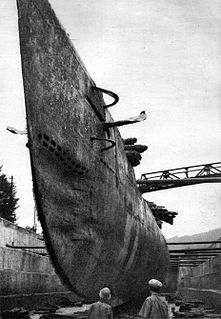
I-33 was an Imperial Japanese Navy B1 type submarine. Completed and commissioned in 1942, she served in World War II, making one war patrol that included the Battle of the Eastern Solomons, before sinking accidentally in September 1942. Refloated and repaired, she sank again in a diving accident during post-repair sea trials in June 1944.

Tempête was the lead ship for her class of two ironclad coast-defense ships built for the French Navy in the 1870s. Even though the ship was not fully commissioned until 1883, she played a minor role in the French occupation of Tunisia in 1881. Tempête accidentally sank a torpedo boat during night maneuvers in 1892 and was placed in reserve later that year. She became the flagship of the local defenses in French Tunisia in 1897 and was decommissioned in 1907. The ironclad served as a target ship for the next several years until she was sunk in 1909. Her wreck was salvaged beginning in 1912, but it was not completed until 1959.
















